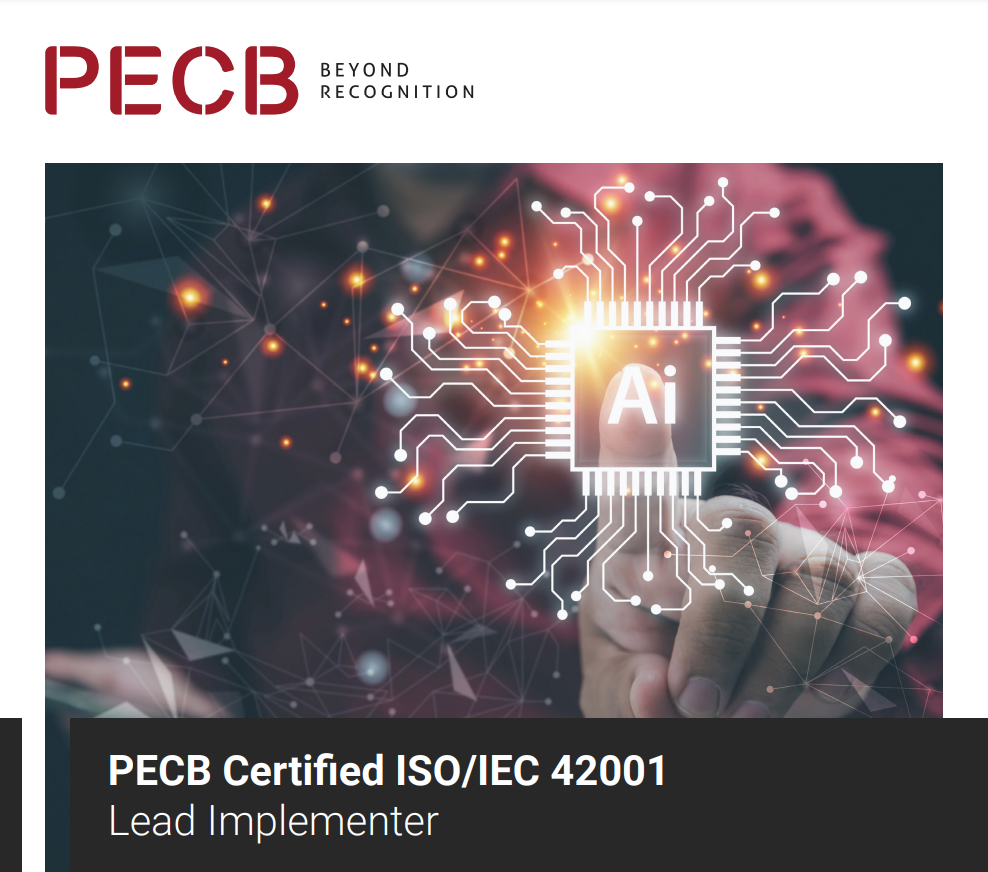Applying ISO/IEC 42001 in finance: AI risk management and compliance
10 minutes read
The financial industry is undergoing a significant transformation with the increasing adoption of artificial intelligence (AI). As AI becomes more prevalent, it is crucial to address the emerging risks and challenges associated with its integration.
Robust governance and compliance are essential to ensure financial stability, customer trust, and regulatory alignment. ISO/IEC 42001 is a critical standard that helps financial institutions integrate AI responsibly, offering numerous benefits:
- Enhanced quality, security, and reliability of AI applications.
- Improved traceability and transparency in AI decision-making.
- Increased efficiency in AI risk assessments and management.
- Greater confidence in AI systems and their outcomes.
In this blog post, we will explore the significance of AI risk management and compliance in finance, the importance of ISO/IEC 42001, and its relationship with emerging regulations like the NIST AI Risk Management Framework (AI RMF) and the Digital Operational Resilience Act (DORA). We will examine the standard's key components, its practical applications in finance, and provide actionable guidance on implementation.
Understanding ISO/IEC 42001
ISO/IEC 42001 is the first internationally recognized standard that provides a comprehensive framework for the responsible management of Artificial Intelligence (AI) technology. It helps organizations use, develop, monitor, and offer AI products and services responsibly, addressing AI-related challenges such as ethics, accountability, transparency, and data privacy. The standard comprises key components, including:

AI risks in finance
The financial industry has embraced Artificial Intelligence (AI) to enhance efficiency, decision-making, and customer experience. However, these benefits come with associated risks that must be addressed. Some of the risks include:
Data-related risks:
- Synthetic Data Risks: The use of synthetic data (1) to train AI models poses risks related to data quality and potential biases.
- Data Quality Risks: AI models are only as reliable as the data they're built on; inaccurate or biased data can lead to faulty predictions and suboptimal decisions.
Operational risks:
- Explainability challenges: AI-driven decisions and actions in finance must be explainable to internal and external stakeholders, including regulators.
- Over-automation: Excessive reliance on AI can lead to overlooking human instinct, resulting in suboptimal decisions and unforeseen risks.
- Systemic risks (2): AI systems can contribute to systemic risks, including market instability and financial destabilization, if not properly regulated and monitored.
- Technical risks: AI systems can malfunction or be vulnerable to cyberattacks, leading to financial losses, regulatory penalties, and reputational damage.
Ethical and cybersecurity risks:
- Ethical concerns: AI-driven decisions can result in unfair, biased, or discriminatory outcomes, compromising reputation, customer trust, and regulatory compliance.
- Embedded biased outcomes: AI models can inherit and amplify existing biases in data, leading to flawed credit decisions, fraudulent activities, and reputational harm.
- Cyber vulnerabilities: AI systems can be susceptible to cyberattacks, exposing sensitive customer data and financial information to unauthorized access.
- Financial stability: Widespread adoption of similar AI models can increase the risk of 'herd behavior' in financial markets, amplifying market volatility and sensitivity to shocks.
- Robustness: AI systems in finance must be robust to ensure accuracy, ethical governance, and safeguard against harmful outcomes.
Applying ISO/IEC 42001 in AI Risk management
A. Implementation and governance
To successfully manage AI risks, organizations must establish a robust implementation and governance framework. Here's how organizations can navigate this process:
Key elements:
- Leadership engagement: Top management must actively drive the development and implementation of the AI management system.
- Establishing a management system: The AI management system must be adapted to the organization's specific needs, objectives, and risk-based approach.
- Clear roles and responsibilities: Defining clear roles and responsibilities is crucial for accountability throughout the organization.
- Regulatory compliance: ISO/IEC 42001 helps organizations meet regulatory requirements such as NIST AI Risk management framework, DORA, GDPR, and CCPA with a structured approach to AI risk management.
- Governance structures: Effective AI governance structures define decision-making processes, allocate resources, and establish clear communication channels. This ensures transparency, accountability, and robust oversight of AI risks.

B. Risk management.
Effective AI risk management requires a structured approach to identify, assess, and mitigate risks. ISO/IEC 42001 provides a framework for organizations to manage AI risks and ensure compliance with regulatory requirements.
- Gap analysis: Conduct a gap analysis to identify differences between your current AI risk management practices and ISO/IEC 42001 requirements. This analysis helps pinpoint areas for improvement, prioritize risks, and select effective risk management strategies.
- Risk assessment and mitigation: Conduct a risk assessment aligned with your organization's objectives and AI policy to identify potential AI risks and their impact. Consider factors like data quality, algorithmic bias, and security breaches. Then, develop a mitigation plan to address these risks, including implementing controls, regular audits, and employee training.
- Ongoing monitoring: Continuously monitor AI systems and processes to ensure alignment with ISO/IEC 42001 and identify new risks. This includes regular reviews of AI policies, procedures, and controls, evaluating system performance, analyzing monitoring results, and ongoing employee training and awareness programs.
Challenges and solutions
Challenges and solutions in implementing ISO/IEC 42001
Organizations face many challenges in implementing ISO/IEC 42001, the international standard for AI risk management.
Ethical challenges
- Biased AI models perpetuating social inequalities, affecting financial service accessibility. For example, AI-powered facial recognition systems have been shown to be less reliable for people with darker skin tones, potentially leading to misidentification.
- Using personal data for model training raises privacy and security issues.
To address these ethical challenges, organizations must prioritize fairness, transparency, and accountability in their AI systems. This can be achieved by:
- Implementing data quality controls to detect biases.
- Conducting regular audits to ensure compliance with ethical standards.
- Establishing accountability mechanisms for AI-driven decisions.
- Involving diverse stakeholders in AI development and decision-making processes.
AI use challenges
- Lack of clear AI strategy aligned with business goals.
- Insufficient personnel knowledge and understanding of AI.
- Inadequate evaluation of AI applications.
To overcome these challenges, organizations must develop a comprehensive AI strategy, provide training and education for personnel, and continuously monitor and assess AI applications.
Technical challenges
- Inadequate or incomplete data.
- Insufficient technical expertise for AI development and integration.
- Difficulties integrating AI systems into existing infrastructure.
To address these technical challenges, organizations must invest in data quality and data governance, develop personnel's technical skills, and ensure seamless integration of AI systems into existing infrastructure.
Continuous monitoring and evaluation
Continuous monitoring and evaluation are crucial to ensure AI systems remain responsible and aligned with organizational goals and values. Organizations must establish mechanisms for ongoing assessment and improvement, including regular audits and risk assessments, continuous training and education for personnel, active engagement with stakeholders and customers, and adaptation to evolving AI technologies and best practices.
Benefits
Implementing ISO/IEC 42001 empowers organizations to navigate AI integration confidently, reaping numerous benefits beyond regulatory compliance. Certification serves as tangible evidence of their dedication to responsible AI deployment, fostering stakeholder trust and affirming ethical practices.
The ISO/IEC 42001 certification contributes to the United Nations' Sustainable Development Goals by encouraging socially responsible and sustainable AI practices.
Future outlook
- Ethical AI leadership: Directors prioritizing ethical AI, with new positions focusing on ethics and governance.
- Data quality and bias mitigation: Emphasis on data quality and bias mitigation for fair AI decision-making.
- Stricter regulations: Regulations like the EU's Artificial Intelligence Act and NIST AI Risk Management Framework ensure transparency, fairness, and accountability.
- Inclusive governance: Diverse stakeholders, including customers and external experts, are involved in AI governance.
- International governance frameworks: International frameworks, like the OECD Principles for trustworthy AI, ensure consistent AI deployment.
- AI auditing and certification: New AI auditing and certification programs ensure responsible AI practices and compliance.
As AI continues to transform the financial industry, responsible AI practices are crucial for building trust, promoting fairness, and ensuring accountability. By adopting ISO/IEC 42001, financial institutions can harness the power of AI while mitigating its risks, showcase their dedication to ethical AI development, foster a culture of transparency, and contribute to a more inclusive and sustainable digital future.
For more information
ISO/IEC 42001 Lead Implementer - Artificial Intelligence Management System (Self-Study)
 Learn More
Learn MoreSelf-study certification course. Certification and examination fees are included in the price of the training course.
ISO/IEC 42001 Lead Auditor - Artificial Intelligence Management System (Self-Study)
 Learn More
Learn MoreSelf-study certification course. Certification and examination fees are included in the price of the training course.
Certified DORA Lead Manager - Digitial Operational Resilience Act
 Learn More
Learn MoreSelf-study certification course. Certification and examination fees are included in the price of the training course.
(1) Generative AI models, trained on anonymous real-world data samples, create synthetic data by first identifying patterns, correlations, and statistical characteristics within the sample data. Once these features are learned, the Generator produces synthetic data that is statistically similar and virtually indistinguishable from the original training data, mimicking its appearance and properties.
(2) Systemic risk refers to the possibility of a complete system failure rather than the failure of individual components. In a financial context, it represents the risk of a cascading collapse in the financial sector induced by interdependence within the financial system, resulting in a significant economic downturn.
Share this article











